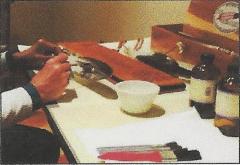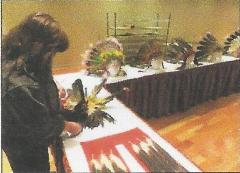 |
Canku Ota
|
 |
|
(Many Paths)
|
||
|
An Online Newsletter
Celebrating Native America
|
||
|
November 2015 - Volume
13 Number 11
|
||
|
|
||
|
Ziibiwing Center
Celebrates 17th Annual Eagle Feather Cleansing, Honoring And Feast
|
||
|
by Joseph V. Sowmick
- Saginaw Chippewa Tribal Observer Photojournalist
|
||
|
Credits: photos by
Joseph V. Sowmick - Saginaw Chippewa Tribal Observer Photojournalist
|
For many indigenous tribes, the eagle remains a steadfast symbol of strength and unity. This is why every year the Ziibiwing Center of Anishinabe Culture & Lifeways estimateds 500 eagle feathers in their sacred and ceremonial collection receive needed attention in celebration of their 17th annual Eagle Feather Cleansing, Honoring and Feast. As he encouraged the audience to "get warm with the spirit of Anishinabe," Ziibiwing Curator William Johnson said the Ziibiwing staff has a lot to be proud of during the Oct. 14-16 event where everyone worked together to prepare. "It is always an honor to work with the Tribal community to cleanse, honor and feast the eagle feathers in our care," Johnson said. "I'm always happy that they consistently bring their own eagle feathers year after year. It is truly a blessing to be able to provide physical and spiritual care for the eagle feathers in our Tribal community." Ziibiwing understands and accepts the physical and spiritual responsibility in maintaining the sacred and ceremonial collection. "It is a lot of work that we take seriously," Johnson said. "The eagle feathers in the sacred and ceremonial collection are well cared for and it shows. Many young people brought their eagle feathers in for cleansing and for that, we're grateful." A Mide' "Little Boy" water drum and sacred pipe ceremony was offered by M'Chigeeng First Nation Ontario, Canada Elder, and teacher Brian Corbiere. Corbiere's spirit name is Bibamikowi (He Who Leaves Impressions) and he is from the Waabizhezhi (Marten) Clan. "It was amazing to have Bibamikowi provide us with spiritual teachings," Johnson said. "We learn so much from him. He is truly a blessing and he has honored us many times in presiding over repatriation ceremonies. He is always there when we need him." Bibamikowi said with the eagle feather cleansing and ceremony is done in the humble way ancestors handed down. "There are many things we don't remember from our Grandfather Teachings and that is why we bring our bundles and sacred medicines to share with the people," Bibamikowi said. "The spirits are here and ready to nourish and join us in the feast. We feed those spirits by providing a spirit plate with all of the gifts given by the Creator for the feasting of the eagle feathers." Ogema Manitou Mukwa (Chief Spirit Bear) Tony Perry, Anishinabe Ogitchedaw Veterans Warrior Society member, assisted Bibamikowi in the ceremony. "All the migizi miigwans (eagle feathers) and the spirits of the eagles speak to each other and they visit while they talk," Perry said. "They are able to connect with each other and communicate as they are brought together from behind closed doors and they visit with the other miigwans. It is good for the eagle feathers to get a cleansing and be able to get some wind on them and for them to breathe." "The eagle flies higher than the hawk and the condor comes from South America and is a relative to both of them," Perry said. "Bibamikowi was gifted that condor feather from the Creator through a South American monk and he hasn't decided what to do with it yet. Along with the many teachings about the importance of feasting eagle feathers, we learn the golden eagle is the one who flies highest to the Creator and the eagle is the only bird that flies courageously into the thunderstorms." Perry said as people go through the storms of life, they can use the spirit of the migizi miigwans and medicine they carry to help them through struggles on mother earth. "Those feathers are gifted to Anishinabe for a reason and when you are having difficulty, that's when you can bring that healing medicine out," Perry said. "That is why we see the miigwans at ceremonies and we need to bring them out all of the time and not just for special occasions." The golden eagle is also twice the size of the bald eagle. Many in the Tribal community brought their personal feathers to be cleansed during this time. Behavioral Health Helping Healer Beatrice Jackson of the Eagle Clan recounted the creation story and eagle teachings with passion. "From the earliest time, we have an understanding of why the eagle is important to us in our lives," Jackson said. "This is told, in part, by our creation story. The eagle feathers displayed at the Ziibiwing Center are an example of honoring the life of the Anishinabe people, past and present, and an honoring of the life and the spirit of the eagle. This gives blessings and strength to our people."
"Cedar, often called giizhik, is a sacred medicine," she said. "The oil from this plant protects the feathers from getting too dry and from any insect that might be in the area. The intact eagle wing is a great healer and works with the energy of the eagle, the smudging material used, and the tobacco offering given by the person requesting the help. Used together, this healing ceremony can bring back the balance of physical, mental, spiritual and emotional well-being. Taking good care of your eagle feathers is essential." Snowbird singers Daisy Kostus and Roxanne Sawade joined Tribal Elder Bonnie Ekdahl as Jackson offered her grandmother pipe to the women during the water ceremony. Raynee Richardo and Isabella Leksche Rosales, Tribal youth, also assisted the women by passing out water ceremony cups to attendees. Ziibiwing Director Shannon Martin said she would like to thank her staff, Julie Whitepigeon, Beatrice Jackson and the Anishinabe Ogitchedaw Veterans and Warriors Society and Bibamikowi for assisting in this endeavor. |
||||
|
|
|
|
||
|
|
||
| Canku Ota is a free Newsletter celebrating Native America, its traditions and accomplishments . We do not provide subscriber or visitor names to anyone. Some articles presented in Canku Ota may contain copyright material. We have received appropriate permissions for republishing any articles. Material appearing here is distributed without profit or monetary gain to those who have expressed an interest. This is in accordance with Title 17 U.S.C. Section 107. | ||
|
Canku Ota is a copyright ©
2000 - 2015 of Vicki Williams Barry and Paul Barry.
|
||
 |
 |
|
|
The "Canku
Ota - A Newsletter Celebrating Native America" web site and
its design is the
|
||
|
Copyright ©
1999 - 2015 of Paul C. Barry.
|
||
|
All Rights Reserved.
|
||

